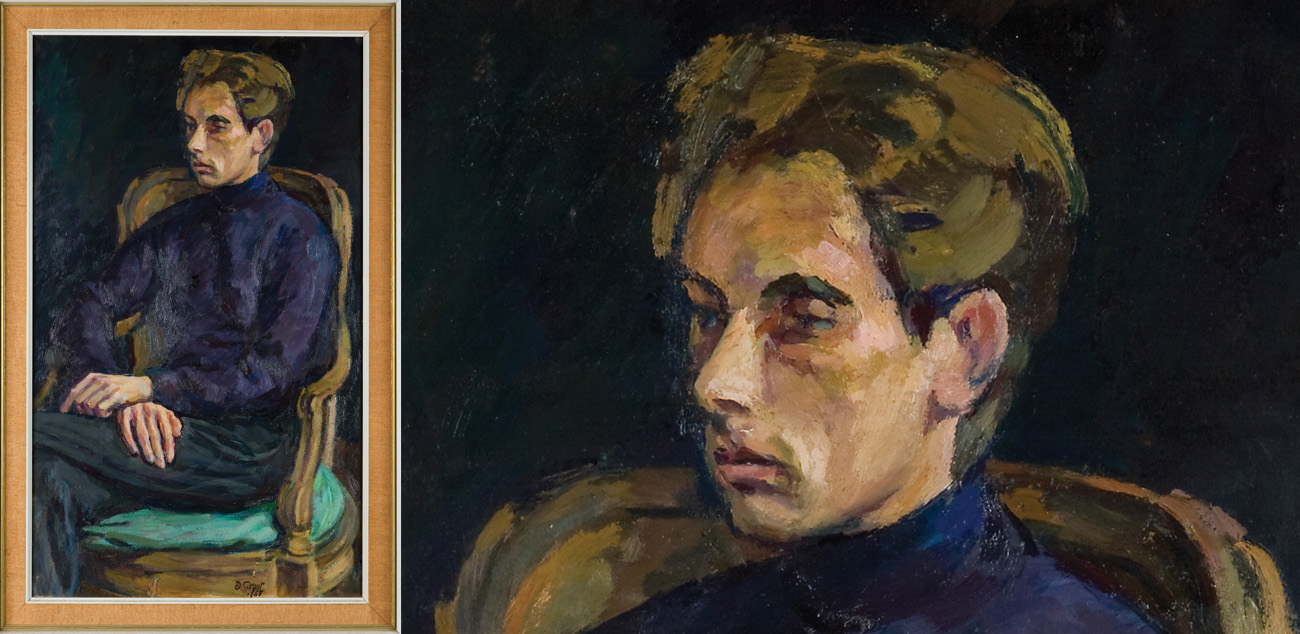Firle Treasures
By Emma Olver
A selection of some of the more notable pieces within the collection at Firle Place in the order you are likely to encounter them on a tour of the house.
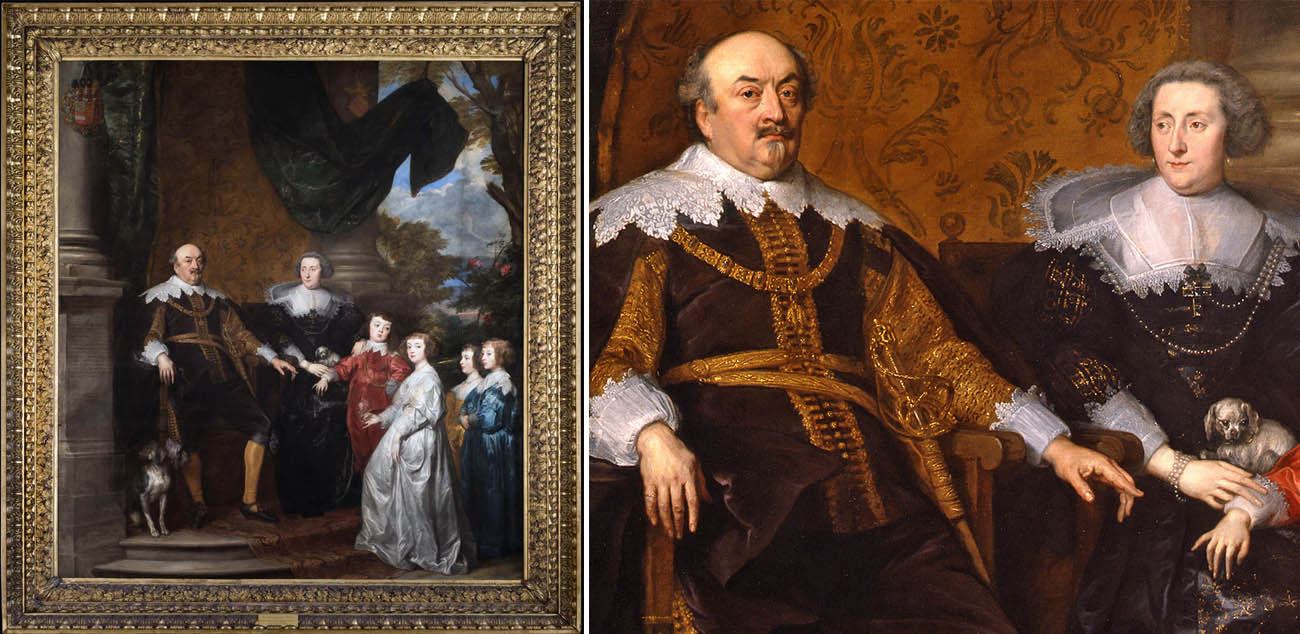
Count John of Nassau-Siegen and his Family
Sir Anthony Van Dyck (1599-1641)
This monumental group portrait of the Nassau-Siegen family is significantly dated 1634, when van Dyck made a brief visit to Brussels because of his guild. Count John (1583-1638) was a member of the family of the Princes of Orange, who led the revolt of the Netherlands against Spain. However, around 1610 he changed sides (and religions) to become a general in the service of the Regents of the Spanish Netherlands.
At the time of this portrait, he was a leading figure in the court of the widowed Archduchess in Brussels, so this would have been a major commission for van Dyck. Count John proudly wears the order of the Golden Fleece, which he received for his services to the Spanish crown. With him are his wife, Ernestina Yolanda (1594-1668), daughter of the Prince de Ligne, whom he married in 1618, and their four children.
The picture was most likely painted for Siegen Castle in Brussels and it is unclear how it left the family’s possession, whether by sale or as a spoil of war. In 1741, it was bought back by another member of the family, Willem Maurits van Nassau d’Auverquerque (1679-1753), who was a distant cousin of the sitters.
Willem’s only son predeceased him and so the painting passed to his elder brother Henry (1673-1754), who had been created 1st Earl of Grantham by King William III. Henry’s sole heir was his grandson, the 3rd Earl Cowper, who was born in 1738, the son of his daughter Lady Henrietta Nassau d’Auverquerque (1712-1747) and William, 2nd Earl Cowper (d. 1764). The painting has thence passed by descent through the Cowper family and is the only painting now at Firle Place with a Nassau d’Auverquerque provenance.
Two Beauvais Tapestries
The Beauvais Manufactory was established by Jean-Baptiste Colbert in 1664. Dedicated solely to the production of tapestries, it was intended to rival the production of Flemish tapestries in Brussels.
These two tapestries are part of the popular ‘Grotesque’ series, produced between 1688 and 1732. The series consisted of six scenes, designed by Jean Baptiste Monnoyer (1636-99), a prominent painter at the French court. Monnoyer was closely influenced by the work of Jean Berain (1640-1711), but also by contemporary Parisian theatre.
The acrobats and theatrical characters depicted in the tapestries would have been a regular feature on the streets of Paris, and recognisable to contemporaries.
Both tapestries show the same scene, called The Camel, but with very minor differences that demonstrate the flexibility of the design.
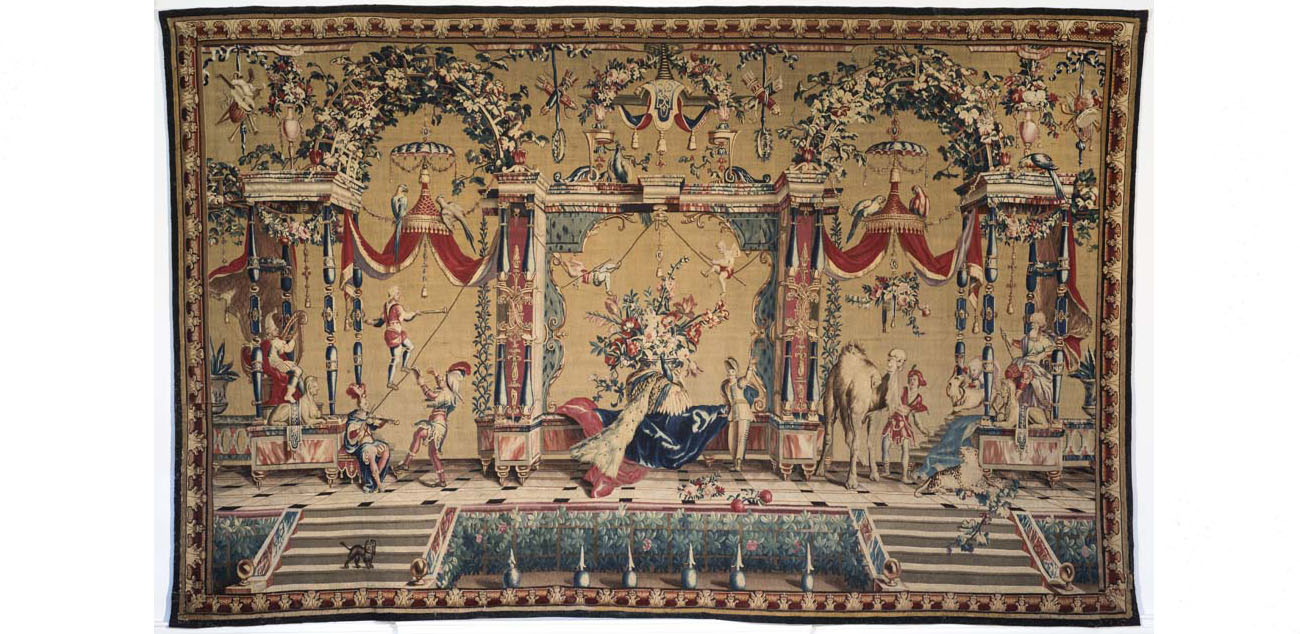
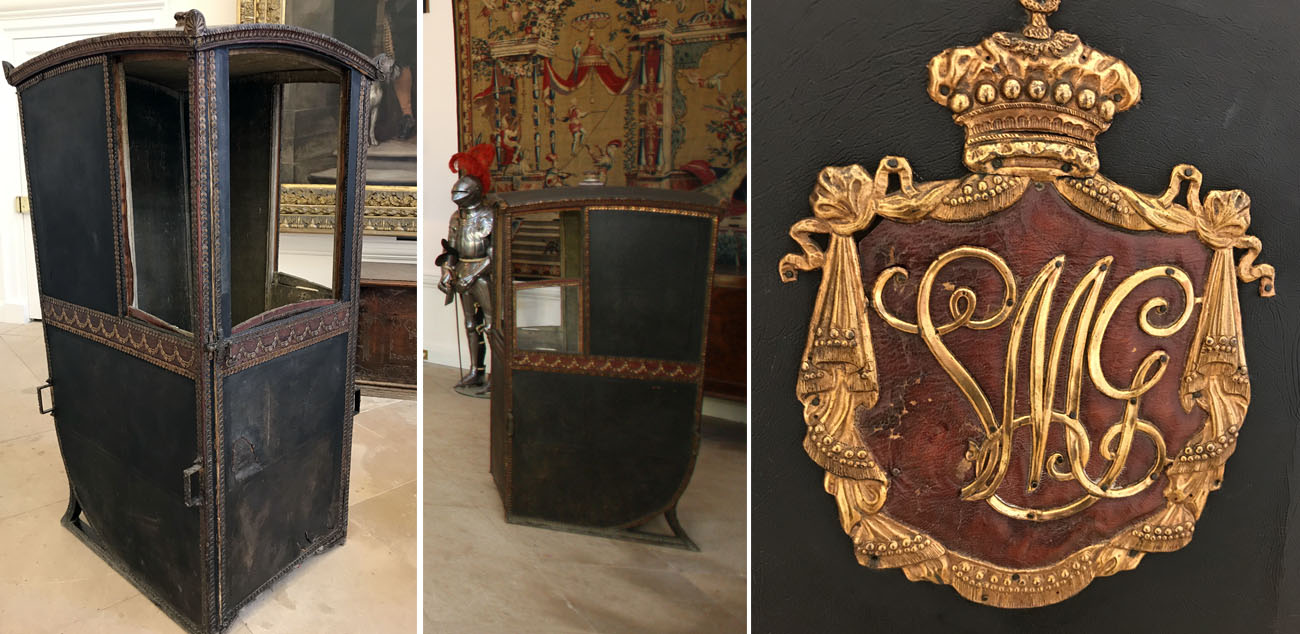
Sedan Chair
This sedan chair was purchased in 1792 by the Henry, 3rd Viscount Gage (1761-1808) from Holmes and Griffin of Whitcomb Street, London, for £46 4s 0d. It was meant for use at his London townhouse, 17 Arlington Street, and records show that it was kept in the front hall. It bears the initials of the Viscount’s wife, Susanna, and was regularly used by her to visit her mother-in-law, Margaret, who lived nearby. It is decorated with fashionable ‘Etruscan’ motifs and is surmounted with a coronet, indicating the nobility of the person within to passers-by.
It also possesses the practical feature of a hinged roof, in order to facilitate access for a lady wearing her hair or a wig piled high.
Extensive Landscape with a Windmill
Philips de Koninck (1619-1688)
Philips de Koninck was a Dutch artist who is most well-known today for his landscape paintings. He was part of a school of seventeenth-century Dutch and Flemish artists whose emphasis on capturing broad horizons and extensive landscapes was to have a huge influence on British eighteenth-century artists such as John Constable and J.M.W Turner.
The celebrated canvas by de Koninck at Firle Place, painted in 1655, is one of a pair that were owned by Horatio Walpole, 3rd Earl of Orford (1783-1858) and hung at Wolterton Hall, Norfolk. In 1857, both pictures were purchased by the collector Charles Pascoe Grenfell (1790-1867), a politician and smelter of copper in Cornwall, and the great-grandfather of the present Lord Gage’s mother, Imogen Grenfell (1905-69).
The pictures hung prominently in the main hall at the Grenfell family home, Taplow Court in Buckinghamshire, until the mid-twentieth century. This picture was brought to Firle in 1954, along with others from the Grenfell Collection. Its pendant, An Extensive Landscape with a Road by a River, also signed and dated 1655, now hangs at the National Gallery, London.
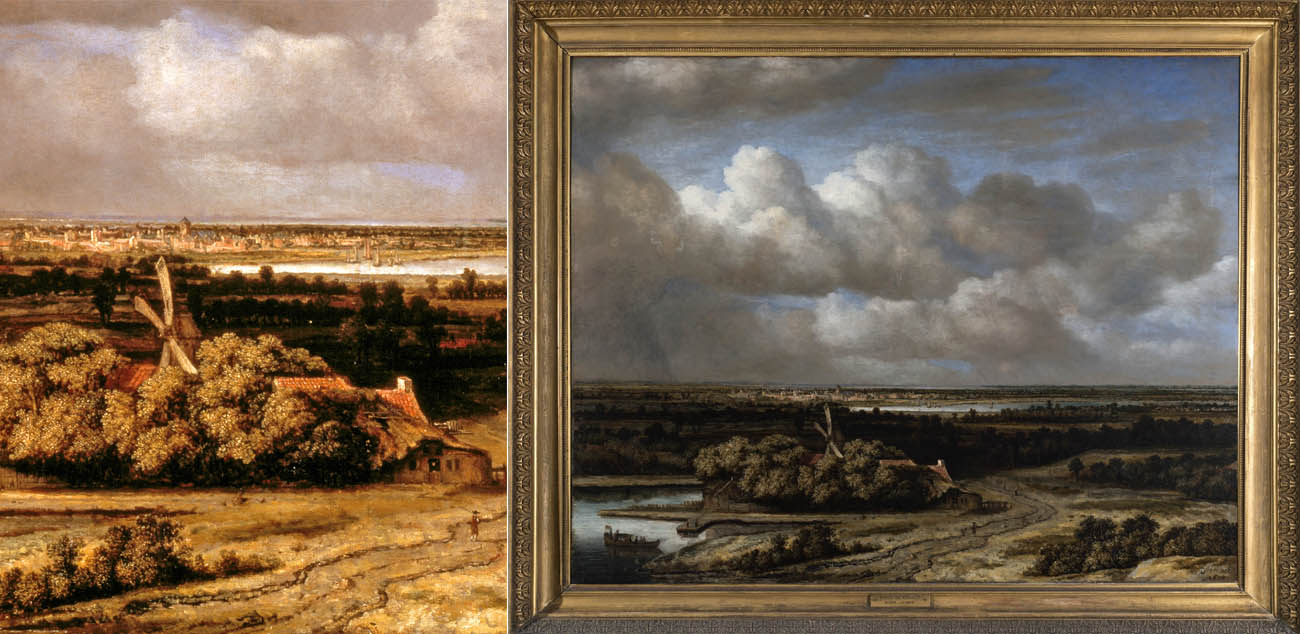

Tudor Doorway
This doorway is a rare survivor from the time of Sir John Gage (1479-1556), who first constructed Firle Place in the late 1530s. However, the doorway is actually significantly older than this and probably comes from the nearby Cluniac Priory of St. Pancras, Lewes, founded around 1080 and built in stages during the medieval period.
The Priory had been destroyed in 1537 as part of the Dissolution of the Monasteries, thus Sir John Gage transported large quantities of Caen stone from the ruins and use it to build his new house. The doorway was adapted to its new setting through the addition of Sir John’s coat of arms (the Ram) and those of his wife, Philippa Guldeford (a burning flame) in each of the corners. The doorway may have originally led into the chapel at Firle, which was swept away as part of changes made in the eighteenth century.
Crystal Chandelier
Attributed to William Parker (active 1772-1784)
This important crystal chandelier is attributed to William Parker (active 1772-1784), and was made between 1770 and 1800. The most prominent features are the inclusion of the Greek urn shape in the middle of the shaft, the tall slender spikes on the upper arms, and the ‘van Dyck’ style drip pans and nozzles.
The central urn in particular is indicative of the Neoclassical style, popular during the late 1700s. This fits with the use of canopies at both the top and bottom of the chandelier, a feature often found on chandeliers inspired by the work of Neoclassical architect Robert Adam. It is interesting to note that a smaller version of this chandelier is in the collection at Paxton House in Berwick-upon-Tweed.

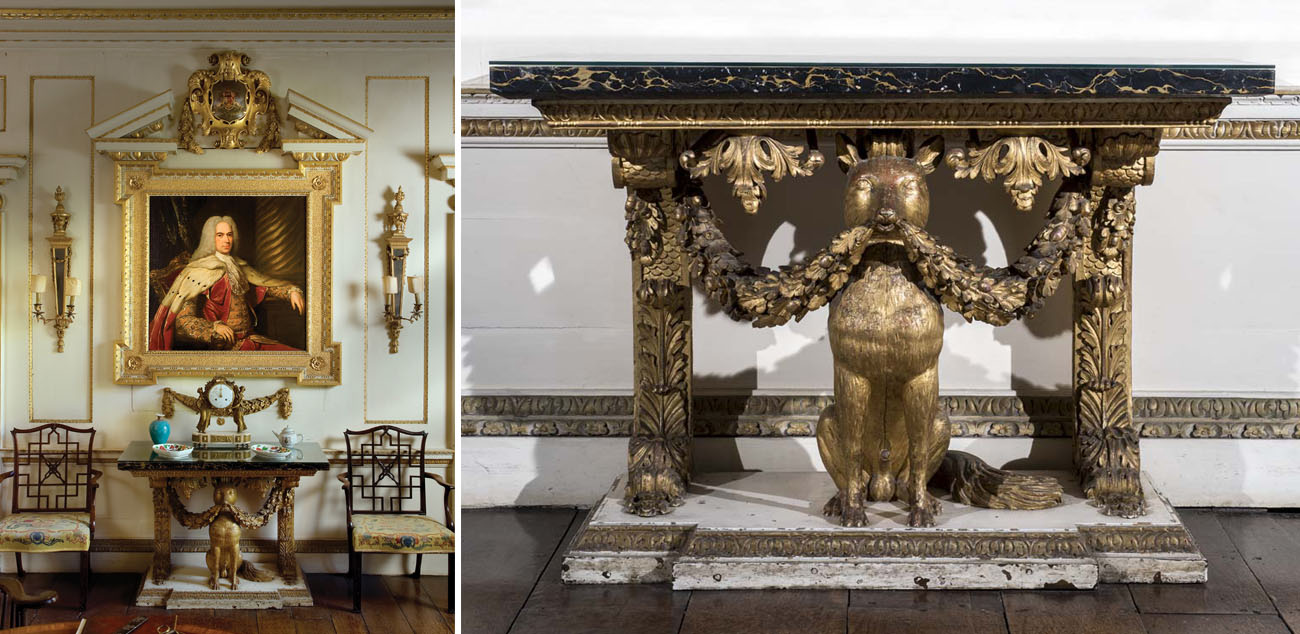
Pair of George II Console Tables with Fox Supports
This pair of gilded console tables, with mottled black Portor marble tops supported by foxes, are very rare and somewhat of a mystery. Another pair of the same design, but not gilded, are housed at Stourhead, in Wiltshire.
The dimensions of the table reflect they were not made for the room in which they now stand, so that it seems likely that they were brought to Firle from another property, possibly another family home such as Highmeadow, in Gloucestershire, which was demolished in 1805, or the London home at 17 Arlington Street. The latter was built by Maria Howard, Duchess of Norfolk (c. 1693-1754) and subsequently bequeathed to the 2nd Viscount Gage. Surviving invoices in the Stoneyhurst archives show that carving work was carried out for the Duchess by John Boson (1720-1743), an associate of William Kent. Little of Boson’s work survives, but these tables imitate his style and sophistication.
William Hall Gage, 2nd Viscount Gage
Thomas Gainsborough (1727-1788)
This portrait of the William Hall Gage, 2nd Viscount Gage (1718-1791), painted in 1777, showcases Thomas Gainsborough’s mature style. The artist’s characteristic placement of his subject within a landscape and use of light, feathery strokes are both visible. William Hall Gage followed his father’s footsteps into court circles and politics, and sat as MP for Seaford between 1744 and 1747. He succeeded to the Gage title in 1754, and married Elizabeth Gideon, daughter of the Jewish financier Sampson Gideon, in 1757.
He is depicted in the undress form of a semi-official Pay Department uniform, relating to his lucrative position as Paymaster of Pensions between 1755 and 1763, and again between 1765 and 1782. Recent cleaning of this picture revealed exciting pentimenti in that Gainsborough had originally painted a dress sword hanging on William’s left side, with a belt and blade that reached all the way almost to the ground, which he later painted out.
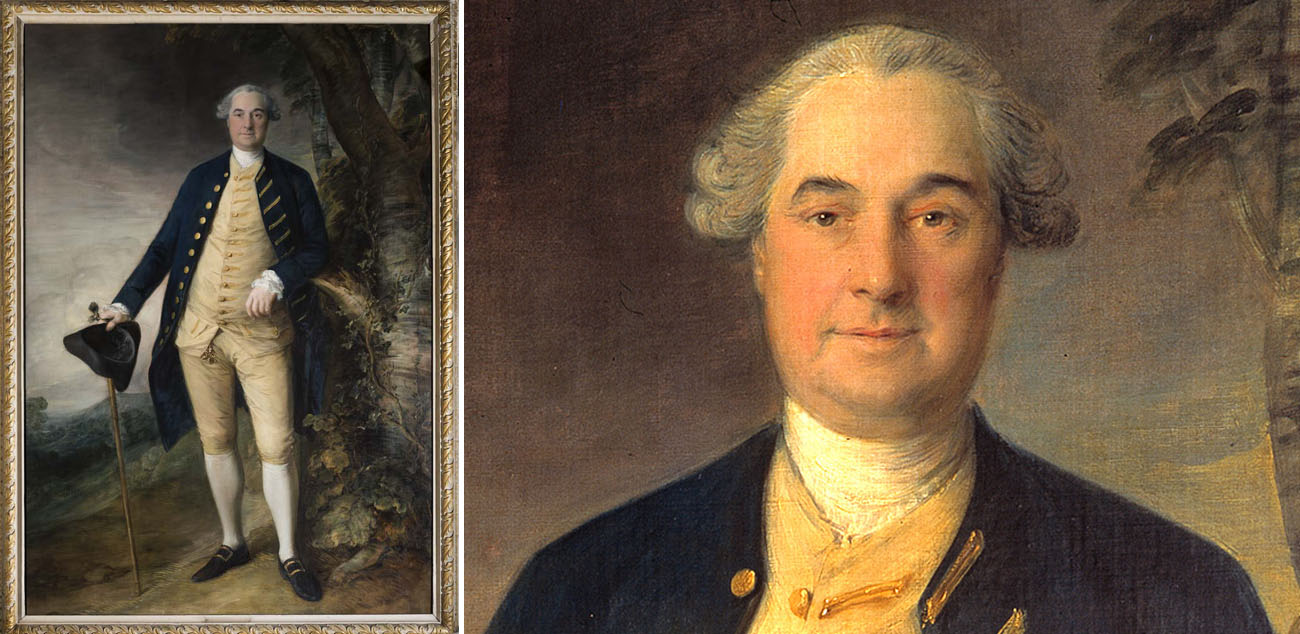

16th Century Antwerp Maiolica Tiles
The thirteen tiles in the Library fireplace, accompanied by nine in store, are all that remains of what was once possibly one of the most striking and sophisticated works of ceramic art in Tudor England. The tiles, made from tin-glazed earthenware (called Maiolica) are typical of those produced in Antwerp from the beginning of the sixteenth century, as a result of the immigration of Italian maiolica potters in 1508.
It is possible that it was Sir John who first brought them to the house and had them installed as part of a grand mural or pavement. The surviving tiles, one of which is dated 1546, indicate a large pictorial scheme (or schemes), showing scenes of the life of Moses from the Old Testament, surrounded by a decorative border. This is directly comparable to a surviving mural at the Vleehuis Museum in Antwerp, dated 1547 and showing The Conversion of St Saul. Given that the Antwerp mural has 98 tiles, it is likely that there were originally at least this many at Firle, making these few a precious survival.
Another rare example of similar tiles in England can be found in the chapel at the Vyne, in Hampshire.
The Melbourne Cabinets
Thomas Chippendale (1718-1779)
These cabinets were commissioned circa 1773 by Peniston Lamb, 1st Viscount Melbourne (1745-1828) from Thomas Chippendale and rank among some of the cabinetmaker’s most important commissions.
The cabinets are decorated in an array of Neoclassical ornamentation, which would originally have been brightly coloured but has faded with time. One of their most unusual features is the use of holly as the principal veneer, which when new would have provided a bright white background to the colourful decoration.
The cost lavished on the cabinets is demonstrated through their resplendent ormolu mounts and the fact that the interiors are lined with mahogany. Although the cost of the cabinets is unknown, a commode very similar in style (known as the Renishaw Commode), commissioned by Lord Melbourne around the same time, was described as costing £140, making it the most expensive piece of furniture supplied by Chippendale.
For more information see the two articles by Jack Metcalfe (CLICK HERE) and James Lomax (CLICK HERE)
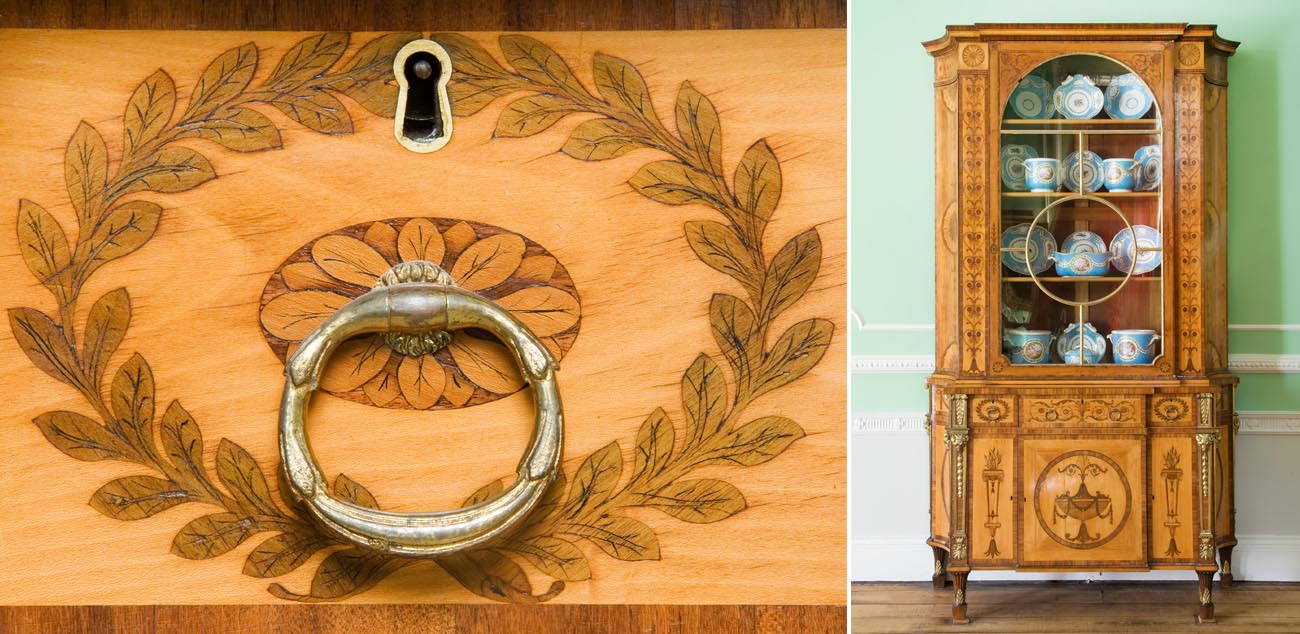
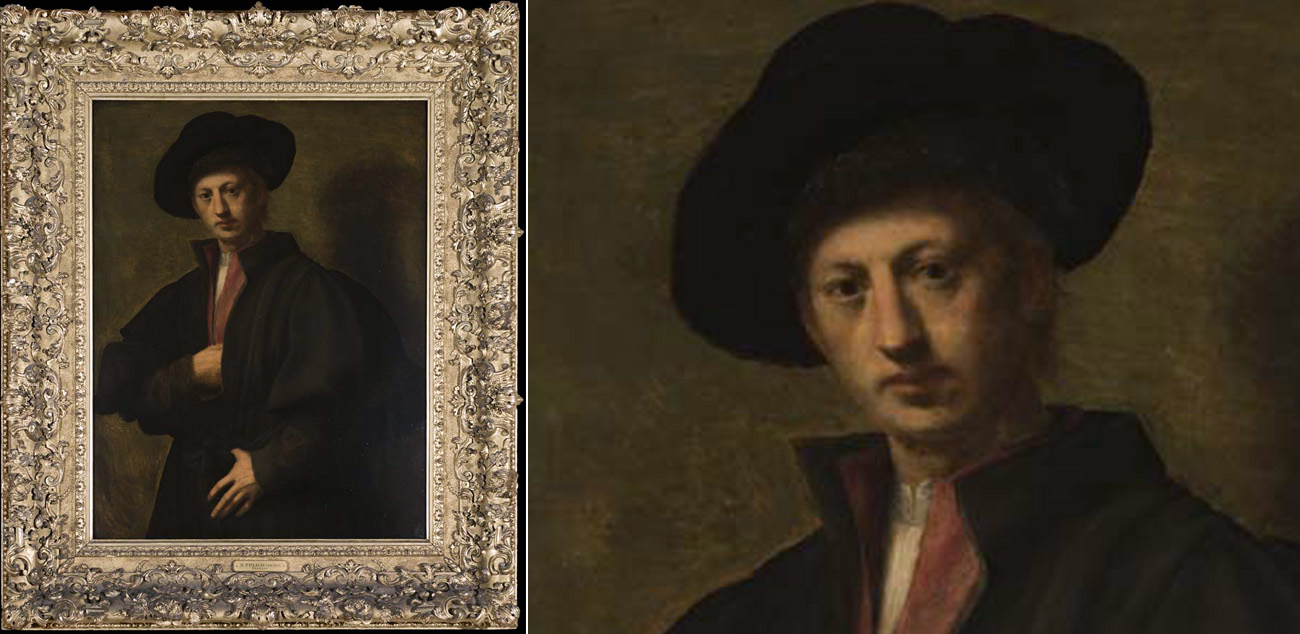
Portrait of a Man, called The Fattore of San Marco, Florence
Domenico Puligo (1492-1527)
Domenico Puligo was an Italian Renaissance artist who worked mainly in Florence. Although the exact identity of the sitter in this portrait is unknown, it is thought to represent the Keeper (or Fattore) of the Dominican church and convent of San Marco, Florence. Considered one of Puligo’s finest portraits, it was bought by George, 3rd Earl Cowper (1738-1789), a direct ancestor of Imogen Grenfell, wife of Henry, 6th Viscount Gage. The 3rd Earl Cowper (known as Viscount Fordwich prior to his father’s death in 1764) inherited at the age of sixteen a vast fortune and art collection from his maternal grandfather.
A few years later, in 1757, he embarked upon a Grand Tour, arriving in Florence in July 1759. He decided to remain there permanently, becoming not only a prominent figure in British-Florentine society, but one of the great art collectors and patrons of his day. His taste appears to have favoured the second generation of northern Italian Renaissance artists, such as Domenico Puligo.
The Lamb Children
Sir Joshua Reynolds (1723-1792)
Elizabeth, Viscountess Melbourne (1751-1818), commissioned this portrait of her three sons, Peniston, William and Frederick from Joshua Reynolds in 1783. Reynolds deliberately emphasised the different stages of childhood through the boys’ varied clothing: Peniston wears breeches, stockings and a tailcoat, indicating his attendance at Eton College; William wears a brown skeleton suit, popular for young boys at the time; Frederick wears a feathered hat and white dress with a pink sash, showing that he is too young to have been breeched (put into trousers).
The picture was intended to hang in the dining room at Brocket Hall, the Melbourne’s country residence, as a pendant to an earlier canvas, Maternal Affection, that Lord Melbourne had commissioned in 1770 to celebrate the birth of his first child; the picture shows Peniston with his mother Elizabeth and hangs near The Lamb Childrenat Firle Place today. The paintings never hung together at Brocket Hall because when The Lamb Children was delivered Lord Melbourne objected and returned it to Reynolds saying, ‘it did not give satisfaction’. This was probably because, of the three children, only Peniston was definitely Lord Melbourne’s son.
Elizabeth went on to have a further three children, Frederick, Emily and Harriet, whose paternity was also questioned as a result of her numerous affairs. This picture remained in Reynolds’ workshop and was purchased after his death from his estate by the 5thEarl Cowper, who in 1805 married the brothers’ sister, Emily.
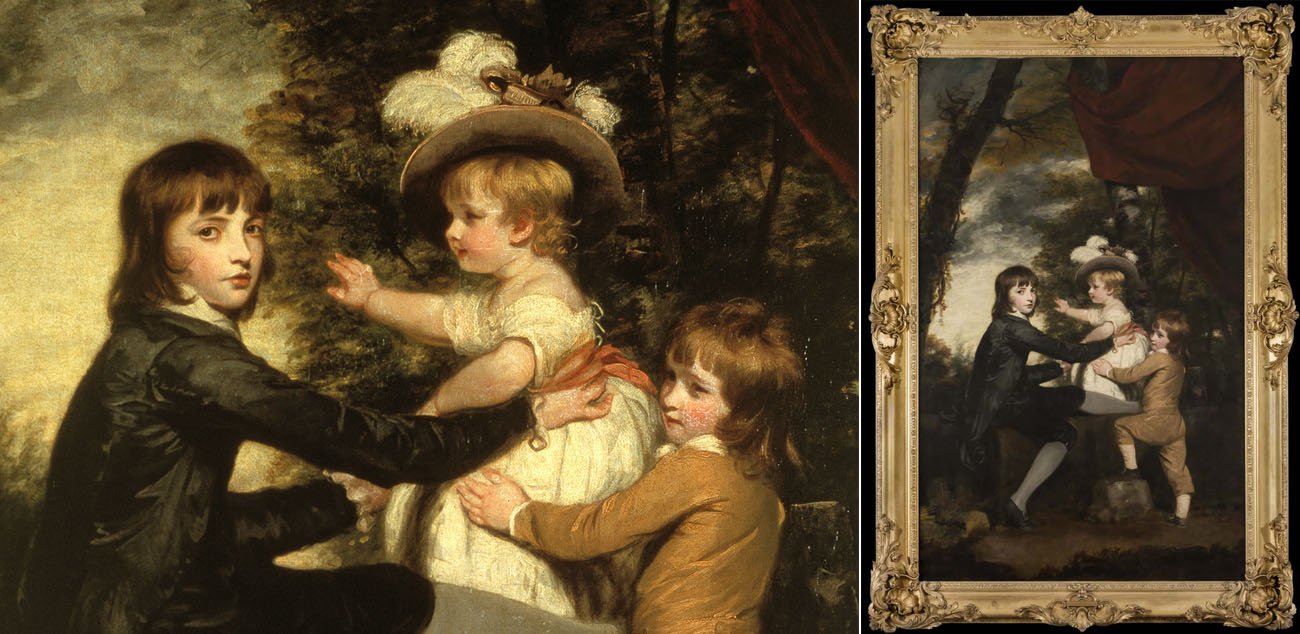
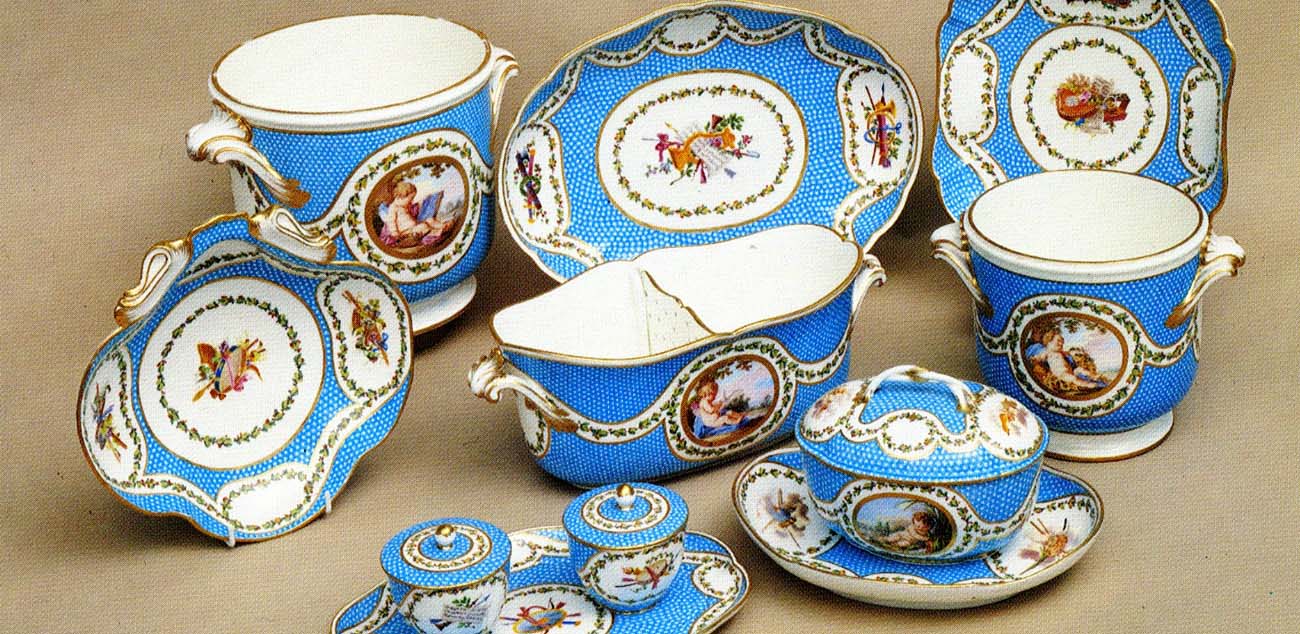
Sèvres Melbourne Dessert Service
This elaborate 80-piece dessert service was commissioned by Peniston, 1st Viscount Melbourne, from the Sèvres porcelain factory in France. It was delivered through his Paris agent on 20 March, 1771 and cost 5,197 livres and 19 sous (about £1 million today). It would have created a sensation upon its arrival, being only the second service to be directly ordered from Sèvres by an English patron. Its decoration, comprising of a turquoise-blue ground with scattered white circles, was also new and had been first used only six months previously on a service for Louis XV’s mistress, Madame du Barry.
The painted cartouches on the service focus on the themes of art, music and love; one in particular shows a putto with an open copy of Hamlet, a clear indication of the Sèvres artists endeavouring to please their patron. Given the pristine condition of this service, as well as its expense, it was probably very rarely used and mainly intended for display.
The service was admired and recorded in Queen Victoria’s diary during a visit to her Prime Minister, William Lamb, the 2nd Viscount Melbourne, at his country home, Brocket Hall, in Hertfordshire.
Sèvres ‘Firle’ Vases
This pair of Sèvres vases, made in 1763, would have been created as part of a garniture, probably a set of five. They correspond exactly with a pair of vase hollandois in the collection of the Rijksmuseum; all are decorated with the same bleu de roi ground, and bear identical date and painter’s marks.
Their design reflects the genius of Jean-Claude Duplessis (1699-1774), artistic director of the Sèvres factory from 1748 to 1774. The vases are designed so that they could be planted with bulbs during the winter months and then easily emptied and refilled with expensive porcelain or cut flowers during the summer.
They are made in two sections; the top is pierced with holes on the underside, allowing water and nutrients to permeate upwards by capillary action, whilst the lower section has trellis work through which to pour water. The cartouches are painted by Charles-Nicolas Dodin (1734-1803), premier painter at the Sèvres factory, and show on one side scenes of Oriental life, popular in the late-eighteenth century, and on the other, stylised floral images, also known as fleurs des Indes. The vases are mounted on nineteenth century ormolu stands.
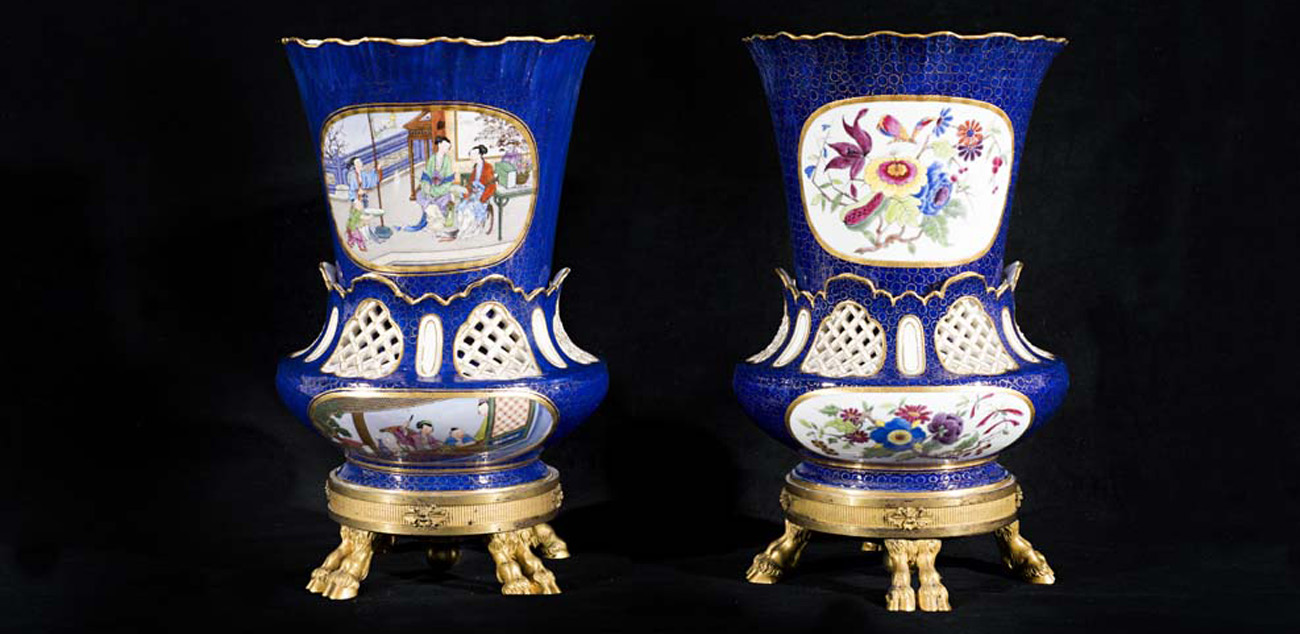
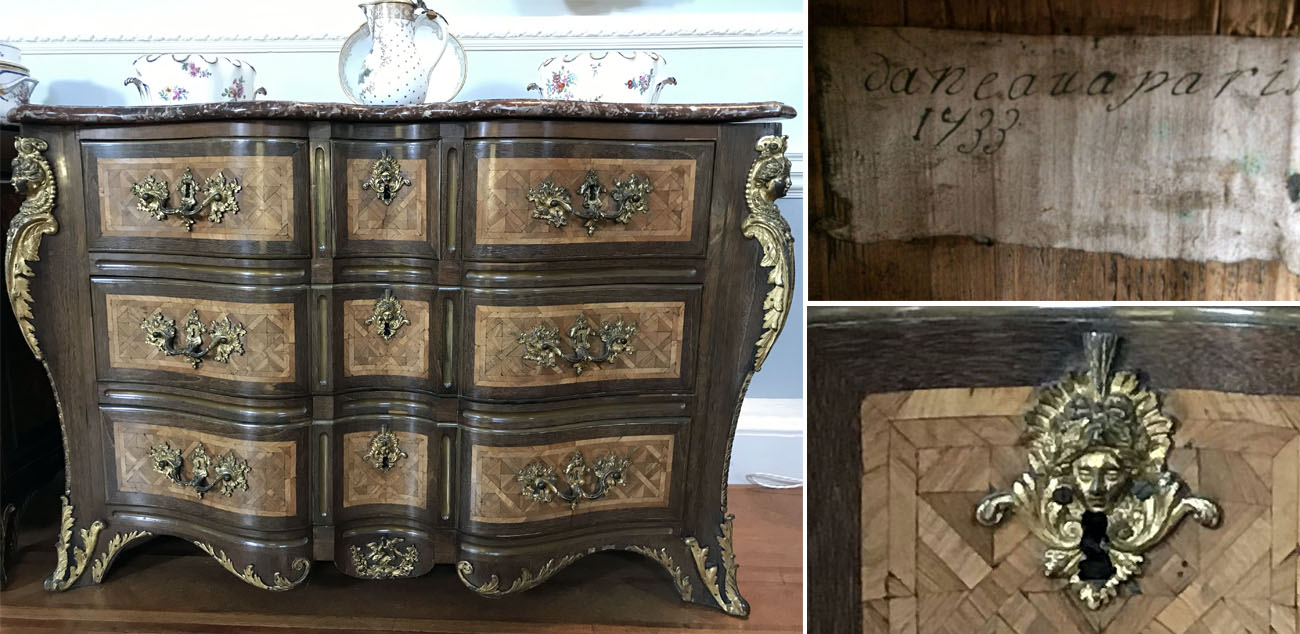
Pair of Commodes
Pierre Daneau (1673-1735)
This pair of French commodes are remarkable for the fact that they have remained together. This is particularly unusual for French furniture due to the Napoleonic Code, adopted in France in 1804, which discontinued the practice of primogeniture and established a system whereby estates are divided among heirs.
The commodes, made in 1733, are typical of the ‘Régence’ period of French decoration, which foreshadowed the more exuberant Rococo of the mid-eighteenth century. Their most exciting and unusual feature is that one of the commodes bears two labels glued to the inner carcass that read ‘Daneau a Paris 1733’. In France, it only became compulsory for ébénistes (cabinet makers) to stamp their furniture after 1743, meaning that before this it is often difficult to precisely identify the maker and date.
Pierre Daneau, the son of a wine merchant, was born in Paris in 1673 and active as an ébéniste from around 1700 until 1735.
George Nassau Clavering-Cowper, 3rd Earl Cowper
Johann Zoffany (1733-1810)
In 1772 Zoffany travelled to Florence at the behest of Queen Charlotte, in order to create for her a painted record of the famous works in the Uffizi Gallery.
George, 3rdEarl Cowper (1738-1789) was one of the foremost British aristocrats living in Florence at the time, and was tasked with introducing Zoffany to Florentine society. This resulted in the Earl’s inclusion in Zoffany’s picture for the Queen, The Tribuna of the Uffizi. The artist also became a mentor to the Earl and helped him in the formation of his collection, for which in 1774, Cowper signed an annuity to pay Zoffany £100 a year.
This portrait of the 3rd Earl appears to have been painted early in their acquaintance in the summer of 1773, and he is depicted probably in the garden of his country house in Fiesole, the Villa Palmieri, with views of Florence beyond. Cowper took a keen interest in court life and the cut of his coat, the fine lace ruffle, the black ribbon hanging from his tie wig at the neck, the gold-trimmed waistcoat, the presence of a sword suspended by a ribbon in addition to a cane suggests that he is wearing Tuscan court dress. The sitter raises his hat in a welcoming salute.
The following year, Cowper became engaged to Hannah Anne Gore (1758-1826) and commissioned a companion portrait of her from Zoffany, dressed as a Savoyard peasant. The two portraits hang adjacent to one another at Firle Place today.

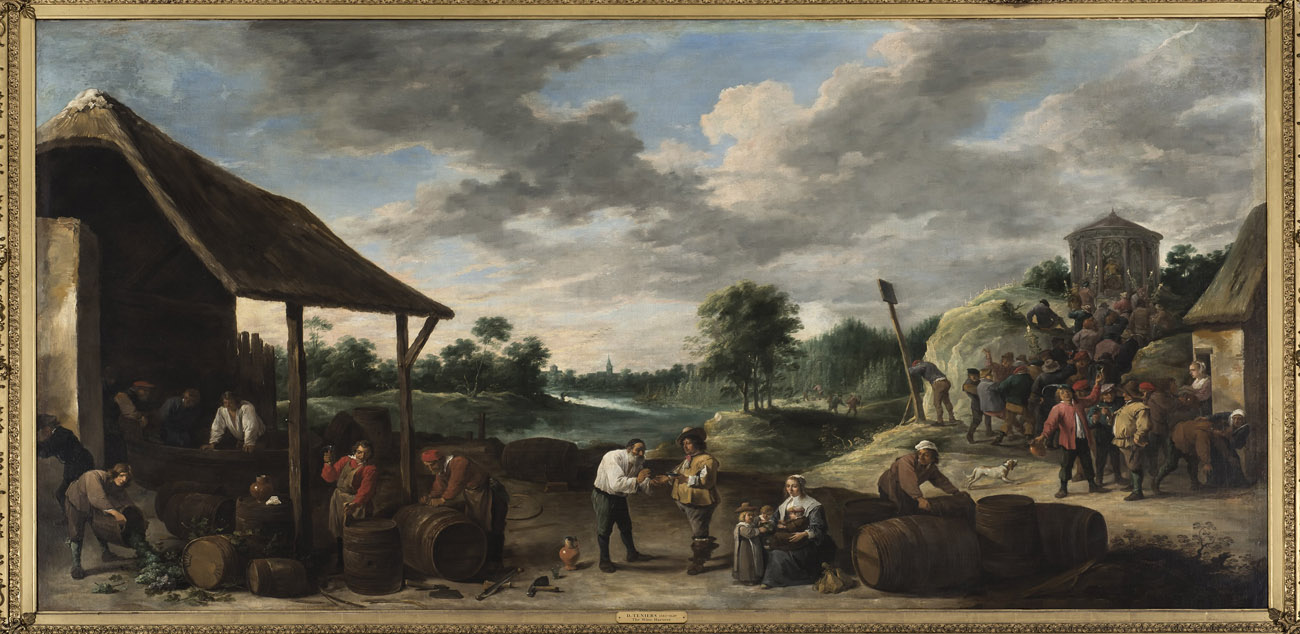
The Wine Harvest
David Teniers the Younger (1610-1690)
This picture vividly depicts a wine harvest in progress. The process unfolds from left to right, beginning with the fresh grapes being tipped from a basket and ending with the wine being joyfully consumed.
The last stage is depicted in the form of a procession, which leads up a hill to where Bacchus, the Roman god of wine, is seated inside a temple on a hillside. It is an unusually large canvas by Teniers, who specialised in genre scenes depicting peasant life, placed in both interior and landscape settings.
The picture was purchased by Peniston, 1st Viscount Melbourne and hung in the dining room of the family seat in Hertfordshire, Brocket Hall. His daughter, Emily Lamb (1787-1869), married the 5th Earl Cowper (1778-1837) and came to inherit all the Lamb family property, which she in turn bequeathed to her grandson, the 7thEarl Cowper (1834-1905). The 7th Earl decided to let the Brocket Estate in 1869 and brought almost all the valuable paintings, porcelain and furniture over to the Cowper family seat at Panshanger.
Because the 7th Earl was childless, Panshanger was reserved for his favourite niece, Ethel ‘Ettie’ Fane (1867-1952), who in 1887 married William Grenfell (1855-1945), later Lord Desborough. Two of their sons, Julian and Billie, were killed during World War I, and their son, Ivo, lost his life in a road accident. Therefore, upon Ettie Desborough’s death in 1952, Panshanger was demolished, the estate was sold and the works of art were divided between her two daughters, Monica Salmond (1893-1972) and Imogen Gage (1905-69), mother of the present Viscount Gage.
George John St. Clere Gage, 7th Viscount Gage
Duncan Grant (1885-1978)
This informal portrait of the 7th Viscount Gage (1932-1993), known within the family as Sammy, was painted in 1967, prior to his inheriting the title in 1982.
It was completed in Duncan Grant’s studio at Charleston Farmhouse, which he and Vanessa Bell (1879-1961) rented from the Firle Estate. As the 7th Viscount took a particular interest in art, he enjoyed spending time at Charleston discussing the subject with Grant. Hence, although the artist has chosen to portray his sitter in a formal pose, the small-scale of the work also creates an intimacy that indicates the friendship between artist and sitter.
